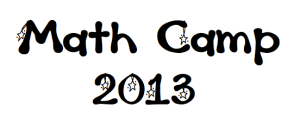 Wow! Math Camp 2013 was a resounding success! The focus each day was on how we can structure routine activities for our students that will allow them to build number sense. We also talked about Carol Dweck’s research about mindsets and looked at how we could help our students build a ‘growth mindse’t in mathematics and not be stuck in a ‘fixed mindset’. (If you have not read Dweck’s book Mindset, I encourage you to get a copy asap!)
Wow! Math Camp 2013 was a resounding success! The focus each day was on how we can structure routine activities for our students that will allow them to build number sense. We also talked about Carol Dweck’s research about mindsets and looked at how we could help our students build a ‘growth mindse’t in mathematics and not be stuck in a ‘fixed mindset’. (If you have not read Dweck’s book Mindset, I encourage you to get a copy asap!)
We looked at visual routines, counting routines, and routines involving number quantity, and discussed how each of these can be utilized for learning.
Our visual routines involved using 10 frames, dot cards, dot plates, 100 dot arrays, fraction pocket charts, percent circles, base-10 grid paper, and number lines (I always have students draw these rather than use ones that are pre-drawn and pre-marked). See end of post to download the various tools.
Our counting routines involved choral counting, counting around the circle, and stop and start counting, and counting up and back.
Our routines for number quantity involved mental math, number strings, “hanging balances”, and decomposing numbers.
It would take too long to write here in one post about how best to use/do each of these ideas, but over time I will get to them. Are you interested in something in particular? Email me and let me know and I’ll get to that one right away!
All of the “math campers” went away with lots of ideas that can be implemented in the classroom right away. I’ll be excited to hear from them how it goes it their classrooms.
I’ll leave you with my favourite definition of number sense: “Number sense can be described as a good intuition about numbers and their relationships. It develops gradually as a result of exploring numbers, visualizing them in a variety of contexts, and relating them in ways that are not limited by traditional algorithms.” (Hilde Howden, Arithmetic Teacher, Feb., 1989, p.11).
There is much food for thought in that quote alone!
Mathematically yours,
Carollee
Click to download: student 10 frames , teacher 10 frames; student dot cards, large 100 dot array, 12 small 100 dot arrays, 6 small 100 dot arrays, 4 small 100 dot arrays, teacher dot cards set 1, set 2, set 3; template for making dot plates; base-10 grid paper, percent circles; directions for making fraction pocket charts;


